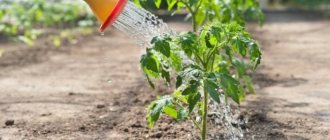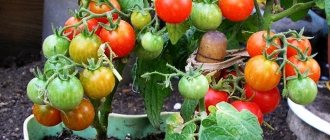When choosing tomatoes for planting, you cannot do without early varieties. The Ladybug tomato bears ripe, juicy fruits already in July. Unpretentiousness, productivity, and endurance to weather changes make this variety a favorite of many gardeners and farmers.
| Height | Landing location | Ripening time | Fruit color | Fruit size | Origin | Fruit shape |
| short | Greenhouse, Open ground | Early ripening | Reds | Average | Variety | Round |
Description and characteristics of the variety
Ladybug is a determinate variety with a bush height of up to 50 cm. Early ripening - 80-85 days pass from germination to the first tomatoes.
Ladybug from "Aelita" is an early-ripening tomato, characterized by high resistance to diseases such as late blight, rot, TMV.
The bushes look neat with an abundance of cherry-red fruits. On 1 fruiting cluster there are simultaneously tomatoes in different stages of ripeness. Fruiting is long lasting, lasting several weeks.
The weight of the fruit is 20 g, the pulp is juicy with an amazing tomato taste. The skin is durable. Tomatoes are shaped like balls. They do not crack when exposed to heat, the pulp remains the same consistency when preserved.
Diseases and pests
Tomatoes of the Ladybug variety are resistant to most typical diseases for these cultivated plants. Although the possibility of developing diseases cannot be completely excluded. In southern regions where there is high humidity and temperature, tomatoes are often infected with late blight. Other possible problems with Ladybug tomatoes include:
- tobacco mosaic (virus);
- mold on leaves, stems, fruits;
- rot of white and gray types;
- anthracnose;
- brown spot.
Typical ladybug tomato pests include:
- Colorado potato beetle;
- scoop;
- whitefly;
- tomato moth;
- bear
To prevent infection and further development of diseases, fungicides are used, and insecticides are used against pests. Regular maintenance of beds and treatment of plants will help minimize the chances of developing tomato diseases.
Features of cultivation and storage
The variety is intended for planting in greenhouses and open beds. The seedling method is used for cultivation.
Seedlings are planted on the site at the age of 50 days. The holes are dug at a distance of 70 cm. The ground is pre-fertilized:
- compost 45 kg;
- superphosphate 30 g;
- potassium salt 20 g;
- saltpeter 20 g.
The dosage is indicated per 1 m2.
Cultivation is carried out using the following procedures:
- watering 2-3 times a week, 3 liters under the root with warm water;
- loosening to avoid crusts;
- mulching with sawdust or straw;
- fertilizing 1-2 times a month;
- formation of 2-3 stems;
- stepsoning once every 10 days.
Ripe fruits are stored for up to 3 weeks in dark rooms without drafts or moisture. Unripe tomatoes ripen perfectly.
Planting and care
Planting and caring for Ladybug tomatoes require certain skills and knowledge. Preparing seeds for planting begins in mid or late March. More exact dates depend on the region. In the Urals and Siberia - no earlier than mid-April. The ripening time of tomatoes should be taken into account - no more than 80 days from the moment the first shoots appear.
Attention! Tomato seeds do not need to be disinfected or germinated. They are placed in the ground dry.
The boxes should be low - 6-7 cm. The soil can be purchased or made independently (peat is used as a basis). Some gardeners treat seeds with stimulants, but in this case this is not necessary. Stages of planting tomatoes:
- containers are filled with moist soil, not reaching the edges by about 2 cm;
- the substrate is lightly crushed (so that the seeds do not subsequently deepen);
- laid out according to a 3 x 3 cm pattern;
- cover with dry soil to the edge, cover with glass;
- ventilate and moisten the plantings with a spray bottle every day.
The number of sprouts depends on the quality of the planted seeds (purchased or your own), and the speed of appearance of the first shoots depends on the temperature.
Ladybug tomato seedlings are transferred to open ground for 45-48 days. The seedlings are prepared in advance and placed in an open space. Otherwise, the leaves will turn white from sunburn. After transplanting into open ground, it is important not to stop caring, abundant watering and fertilizing.
Agrotechnics of cultivation
Tomato Tourmaline
From the description of the variety, you can understand that the Ladybug tomato is unpretentious in cultivation. However, without competent agricultural technology, high yield results cannot be achieved.
Additional Information. When purchasing seeds, do not forget about the quality of the seed. It is necessary to make sure that they meet the requirements of the State Seed Inspectorate. When choosing seeds, be sure to pay attention to the year they were released. The best germination will be for seeds produced no later than 2 years ago.
Loamy and sandy soil
Loamy and sandy soil is most suitable for growing tomatoes. For good fruiting and high disease resistance, the soil for growing tomatoes must be enriched with nutrients (organic and mineral fertilizers). Organic sources include rotted manure, chicken manure, compost and humus. Mineral fertilizers – ammonium nitrate and superphosphate. Experienced gardeners also add wood ash to the soil. It will enrich the soil with potassium and protect against many insect pests.
Tomatoes are grown in seedlings. Seeds are planted for seedlings in late February - March. It is best to use wooden boxes as containers for planting seeds. Before filling them with soil, you need to disinfect the containers. After this procedure, you can pour drainage (expanded clay) onto the bottom of the container, and then fill it with moist, nutritious soil. Now you can sow the planting material to a depth of 2 cm.
Before sowing the seeds, it is recommended to treat them in a solution of potassium permanganate (2.5 grams per 1 cup of water), then rinse with clean water and dry slightly.
To accelerate seed germination, biostimulating solutions are used.
Important! After planting the seeds and until the seedlings of the crop get stronger, they should be watered with warm water from a spray bottle. If you water the crops with running water, the seeds will go deep into the soil and will not sprout.
After the first two leaves appear, young plants need to be picked. It is better to plant them in separate peat pots or in special boxes with recesses for plants.
This crop does not like cold weather, so it is important to monitor the room temperature; the permissible temperature limit is 18°C.
Young plants require a large amount of light, at least 12 hours a day.
Important! If the room where the seedlings are located is not sufficiently lit, then lamps should be installed for additional illumination.
Lamps for additional lighting
Seedlings must be fed with complete fertilizer 2 or 3 times and ventilated. A week before planting, it must be hardened. Hardened seedlings produce a much larger harvest.
Vegetable growers recommend treating them with copper oxychloride before planting seedlings. This will help protect young plants from fungal diseases. It is better to plant seedlings in the beds in the afternoon, when the sun is less active.
Seedlings can be planted in a heated greenhouse in April, and in an unheated greenhouse in May. Plants are also planted in open ground in May. The recommended distance between plantings is 70 cm.
Tomatoes are heat-loving and do not like groundwater lying close to them, so the optimal place for planting is a well-lit, hilly area. The first harvest will appear in July.
If you want to grow tomatoes, but don’t have a garden, then the Ladybug tomato variety is suitable for growing in apartment conditions on the balcony.
Although this variety is unpretentious, it still needs care, it requires:
- Water regularly. The crop should be irrigated with warm water. The soil should not become too dry. Drip irrigation can be used;
- Tie up. The branches are simply strewn with fruits; under their weight, the bushes lie on the bed. Pegs and linear grids are used for gartering;
- Pinch. The bushes are spreading and require pinching; leaves and shoots will have to be plucked off every 10 days. This procedure helps avoid shading, which increases the risk of disease and leads to slower fruit ripening. It is recommended to remove the stepsons in the morning so that the wounds dry out faster;
- Remove weeds. So that they do not take all the nutrients from the soil, thereby depriving the cultivated plant;
- Feed in a timely manner. A single application of nitrogen fertilizer will help increase the yield;
- Mulch. You can mulch the soil with straw or sawdust. The procedure is necessary to reduce the risk of tomato diseases and protect fruits from rot in bad weather conditions. Since the branches are heavy and droop to the ground, even with excess moisture, the tomatoes may rot.
Pests liked Ladybug tomatoes. Garden snails and ants are of particular concern to gardeners. Snails can destroy an entire crop in a short time. And ants are accomplices of aphids, which eat the inflorescences. They usually fight against aphids and ants using agrochemicals (“Aktofit”, “Profi”).
Pests - garden snails and ants
Snails really don’t like crushed eggshells; they should be scattered on the beds.
What attracts gardeners
Breeders worked to create an early ripening variety for open ground. Practice has shown that plants bear fruit well even in unheated greenhouses. When it gets colder, it is recommended to cover the plantings with film or non-woven material.
Description of Ladybug:
- early ripening variety (from pipping to the first harvest 80 days);
- determinate bush (grows
- leaves are small, light green;
- 2-3 brushes on the stem;
- tomato is resistant to late blight;
- yield up to 9 kg/m².
Children love to eat Ladybug tomatoes. They are attracted by the shape and sweetish taste of the berries.
What do the berries look like?
The bushes are quite decorative. Low-growing plants are strewn with small, dense fruits. Berries of green, light brown and red colors hang on one brush.
Characteristics of tomatoes:
- weight 20 g;
- thick skin;
- sweet and sour taste;
- juicy pulp;
- ball shape;
- smooth to the touch.
Ladybug decorates salads. Tomatoes do not crack during heat treatment, the pulp retains its consistency. Assorted vegetables diversify the winter menu.
Unripe fruits ripen easily in a dark pantry. The thick skin ensures delivery to the place of storage or sale.
The advantages of the variety are appreciated by gardeners: Ladybug is included in the State Register of Vegetable Crops of the Russian Federation. Recommended for growing in summer cottages and private plots.
Advice from agricultural technicians
The gardener who grew Ladybug knows: the harvest depends on competent agricultural technology. It is common for tomatoes:
- start seedlings in the third decade of March;
- The plants must be pricked down to the cotyledons;
- ventilate, feed, harden seedlings;
- maintain a temperature of 18 ⁰C;
- follow the watering schedule;
- place in a permanent place after late spring frosts;
- pre-fill the ridges with mineral complexes;
- layout: 50 cm x 70 cm;
- requires feeding with nitrogen (one time);
- mulch the soil with straw, sawdust, non-woven material;
- To optimize water consumption, provide drip irrigation.
People fell in love with this unpretentious compact plant. The gardener planted a ladybug this year and will plant it next year.
Methods of protection against diseases and pests
Tomato is resistant to some diseases. Early ripening eliminates late blight. But the bushes, overloaded with fruits, fall to the ground. Tomatoes begin to rot in cool, humid weather. Mulching the beds will reduce crop losses.
The ladybug was appreciated by pests. Garden snails can destroy berries in one night. To prevent aggression, crushed eggshells should be scattered on the ground.
A summer resident planted a ladybug near her neighbors' abandoned plot. The plants were eaten by aphids. The flowers have fallen, the fruits have not set. Aphids can be eliminated by timely destruction of anthills, treatment of plants with industrial insecticides or folk remedies.
Gardeners' opinion
Gardeners give good reviews about the Ladybug. They like productivity, early ripening, and transportability. People appreciated the universal purpose of the fruit and the ease of growing the crop. The unripe fruits are ripened in the dark. Prepared canned food decorates any dish.











